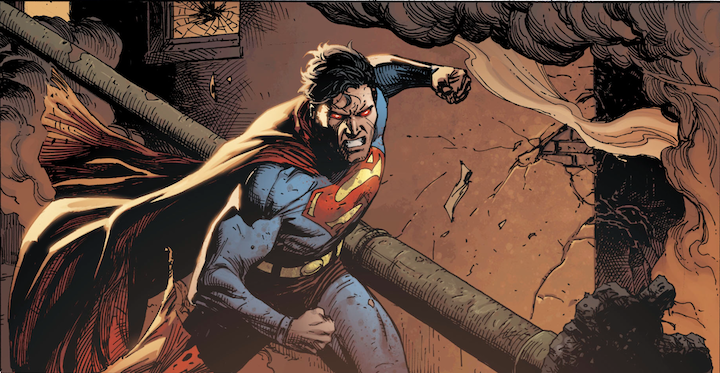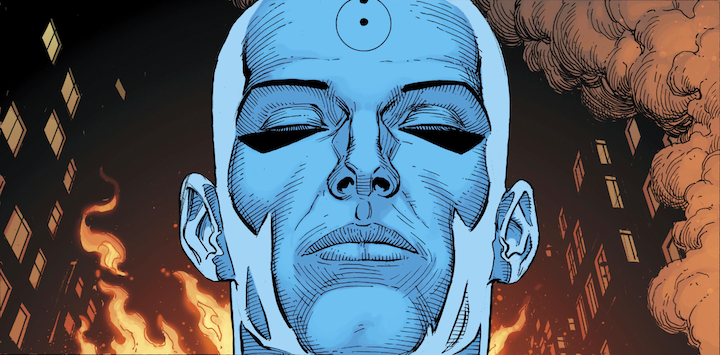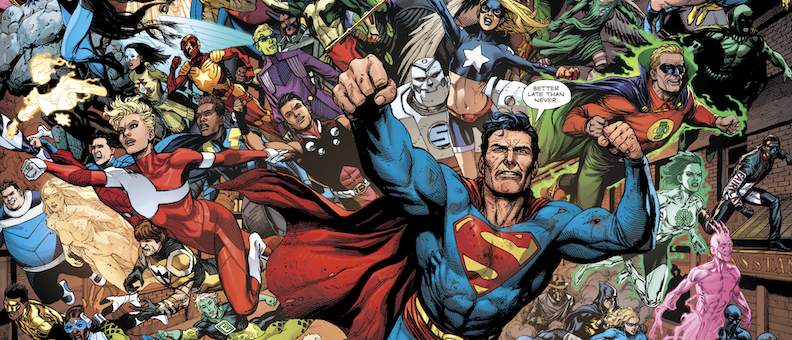The long-awaited and much-delayed finale to Geoff Johns’ meta take on the DC Universe has arrived, and it packs quite a punch. But is it too late to make a difference to the DCU at large?
Doomsday Clock 12
Written by Geoff Johns
Pencils and Inks by Gary Frank
Colors by Brad Anderson
It is November 22, 2017. I am reading the FIRST ISSUE of a much-hyped new monthly maxiseries from writer Geoff Johns and artist Gary Frank.
It is March 28, 2018. After a two-month wait, I am reading the FOURTH ISSUE of Johns’ and Frank’s Doomsday Clock.
It is December 5, 2018. The EIGHTH ISSUE of Doomsday Clock is released after a three month gap.
The road to this week’s final issue of Doomsday Clock hasn’t exactly been easy. As excited as everyone was at the promise of the story when it was originally announced, taking 25 months to finish what was supposed to be a monthly 12-issue series is a lot to ask of a consumer. When you guarantee – as DC Comics did – that the ending of the maxiseries would make considerable hanges to its comics universe, it’s pretty important that you deliver.
It’s hard to deny that Johns and Frank did deliver with the final issue. Sure, the promised confrontation between Superman and Watchmen’s Doctor Manhattan didn’t really turn out to be much of a fight. But the point of the story wasn’t really about that confrontation. DOOMSDAY CLOCK evolved into something entirely different. It became a treatise on the nature of comic book continuity and a sourcing mechanism to explain how things can change so drastically in the DC Universe while always coming back to something familiar.
In the late 1990s, a decade after DC’s multiverse had been wiped out in Crisis on Infinite Earths, Grant Morrison created the concept of Hypertime to ensure that every story had a place somewhere. With DOOMSDAY CLOCK, Johns gives reasoning for the different eras of continuity, centering them around Superman and giving an explanation for how they came about: the god-like Jon Osterman, Watchmen’s Doctor Manhattan, spent lifetimes fiddling with the universe to create new iterations of Superman to see how things change around him.

And when Doctor Manhattan finally explains all of this to Superman, in the midst of a giant battle with superpowered people from all around the world, Superman’s reaction could not be more perfect. Manhattan expects Superman to end his life in response to his meddling. Instead, Superman does what he always does: he reaches out to Manhattan to create an ally instead of another enemy.
While he didn’t have a lot to do with the first half of this series, DOOMSDAY CLOCK eventually became a love letter to the Man of Steel and what he means to the DC Universe and, by extension, our universe. The 11 issues leading up to this finale were filled with darkness and impending doom, but the ending had a sense of hope that frequently gets lost in DC’s more modern take on the superhero genre.
When the maxiseries was originally announced, there were grand plans to incorporate the ending into the larger DC Universe, jumping stories ahead one year so the conspiracy theory at the heart of the series could play a role in what was to come. It was also meant to bring the Legion of Superheroes and the Justice Society back into the fold, as they had both been missing for quite some time. But it seems like the book’s delays and bringing Brian Bendis in to write Superman has made a lot of what was happening here irrelevant.

Bendis used his writing on Superman and Action Comics to bring the Legion back, making Superman’s son a major player in the team’s continuity. And the conspiracy Bendis created through the EVENT LEVIATHAN story seems to have wiped away what Johns was crafting here. With all the delays, and the changes that came about in the 25 months between the first and last issues, I’m not sure Doomsday Clock will be remembered as the major event that reshaped the DC Universe as it was intended.
But it will, at the very least, be remembered as another great story from Geoff Johns.
